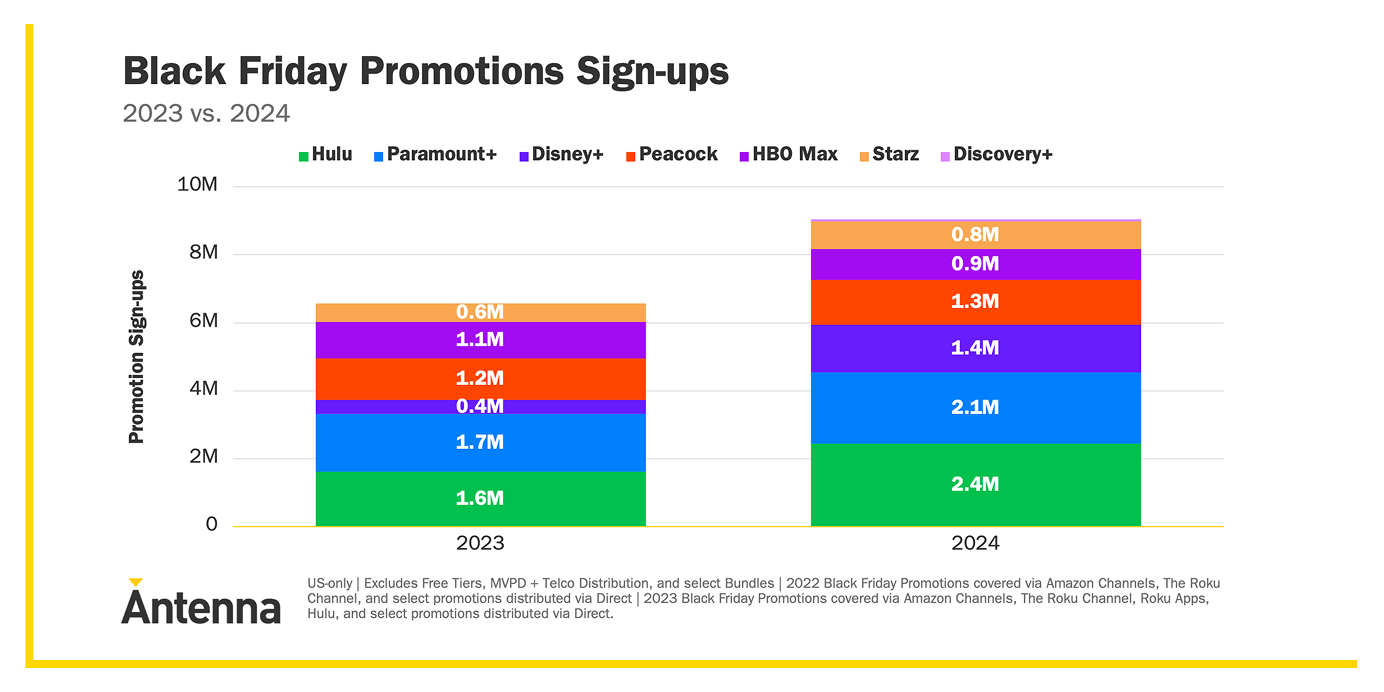NOTE: This post includes Antenna data first reported by The Wall Street Journal on May 23, 2024.
Bundling has dominated headlines recently. During the month of May alone:
- Disney and Warner Brothers Discovery announced that Disney+, Hulu and Max will be offered together;
- Comcast announced plans to offer a service bundle with AppleTV+, Netflix, and Peacock;
- The name for the soon-to-launch sports streaming joint-venture from Disney, Fox, and WBD was introduced.
For media companies, the concept of bundling isn’t new. But as streaming continues to evolve, bundling is increasingly viewed by the industry as a tactic to both attract new customers and mitigate churn.
So what makes a good bundle in a direct-to-consumer world? Subscriber Overlap is a relevant metric to use as a starting point.
Antenna is able to estimate the number of individuals who subscribe to multiple services. For instance, Antenna finds that Max Subscribers are 2.53x more likely to be subscribed to Apple TV+ compared to the General Population.

It could be interpreted from a high rate of overlap that particular services are strong candidates to be bundled together because consumers have shown interest in each. But, while high overlap indicates an affinity between the two services, it also could indicate that a discounted bundled offering might be cannibalistic because many consumers already are willing to pay full price to each service.
To differentiate between a cannibalistic bundle versus one which would add economic value, Shishir Mehrotra introduced the concept of Casual and Super Fans in his insightful analysis, Four Myths of Bundling. His framework served as an inspiration for this Antenna analysis.
Antenna established a new concept named “Curious Customers”. Antenna defines Curious Customers as individuals who have canceled a service in the past, or are currently subscribed with a tenure of six months or less.
At the end of Q1’24, Antenna data indicated that Hulu had the largest numbers of Curious Customers at just under 45M. Those are individuals who have shown enough interest in Hulu to try it, but have not committed to long-term loyalty. Netflix had the fewest Curious Customers.

What about subscribers who have a tenure longer than six months? Antenna calls them Committed Customers. Analyzing the size of a services’ Curious Customers relative to their Committed Customers is an interesting way to think about the potential upside or cannibalization which bundling could provide to the service in general.

Most Premium SVOD services have more Curious Customers than Committed Customers. The ratio is highest for Max; of all the people who Antenna has ever observed subscribing to Max, 28% of them are currently subscribed with a tenure longer than six months. This suggests that Max has significant potential upside from using bundles to motivate Curious Customers to subscribe more loyally, with less risk of losing revenue from existing loyal subscribers “trading down” to a lower cost bundle.
For Netflix, on the other hand, two out of every three individuals who have ever subscribed to the service are currently subscribed with a tenure over six months. Bundles represent more cannibalization risk, with less upside potential.
Taking this another step, the most productive bundles will pair services with a strong overlap between Curious Customers. These Curious Customers have displayed a willingness to pay for each service, but not a high level of loyalty to them. As such, the discounted bundled offering has a large base of individuals who may be prompted to engage more loyally with both services together than they were with either service on a standalone basis. This represents strong upside potential for both participating services.
The least productive bundles maximize Committed Customer overlap. These Committed Customers have shown a willingness to pay for a given service, and a higher level of loyalty. As such, offering them a discounted bundle could be value-destructive.
Antenna’s Q2’24 State of Subscriptions will delve into this concept in more detail. If you’re not already signed-up to receive our quarterly State of Subscriptions reports, you can submit your information today to make sure you get your own copy when it's released next month.
For more detailed information on Antenna’s methodology and definitions of core metrics, please visit http://www.antenna.live/methodology.

.png)



